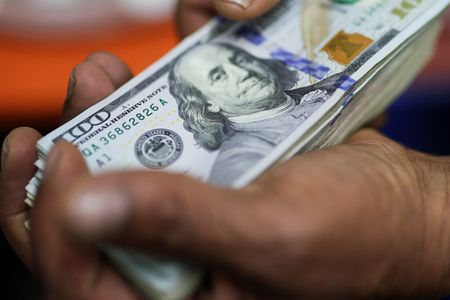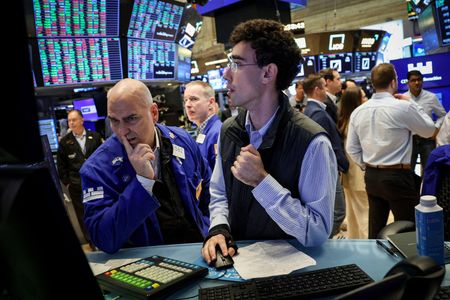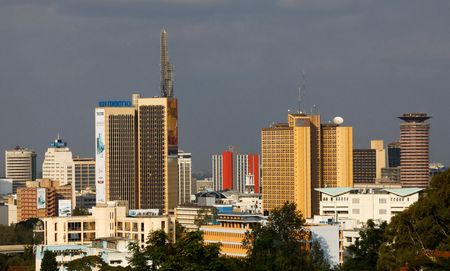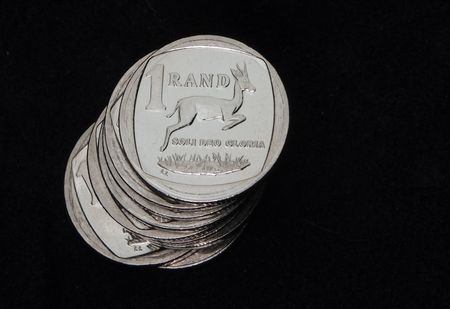By Gertrude Chavez-Dreyfuss
NEW YORK (Reuters) -The dollar fell on Tuesday following softer-than-expected economic data, as investors awaited a likely U.S. government shutdown that could disrupt the release of the monthly nonfarm payrolls report this week.
Government funding expires at midnight on Tuesday (0400 GMT) unless Republicans and Democrats agree to a last-minute interim deal.
“The shutdown is pretty much well-priced in by the market,” said Eugene Epstein, head of trading and structured products, North America, at Moneycorp in New Jersey.
“The question is how long the shutdown is going to be – if it’s a few days as the market seems to be expecting at the moment, or is it actually going to prolong into something bigger?”
U.S. President Donald Trump warned congressional Democrats on Tuesday that letting the federal government shut down at midnight would allow his administration to take “irreversible” actions including shutting down programs important to them.
The U.S. Labor and Commerce departments said their statistics agencies would halt data releases in the event of a partial shutdown, including closely watched employment data for September.
The payrolls report, due Friday, is crucial for Federal Reserve decision-making, so a delay could generate extra market volatility, as uncertainty among investors increases.
“The logic is that a government shutdown could lead to a more dovish Fed,” said Elias Haddad, senior markets strategist at Brown Brothers Harriman in a research note.
“If a shutdown is brief, the Fed will ignore it. However, a prolonged shutdown (more than two weeks), increases the downside risk to growth and raises the likelihood of a more accommodative Fed.”
U.S. rate futures are pricing in 45 basis points of easing this year, most likely starting with 25 bp in October, with a strong chance of a second by year-end.
In afternoon trading, the dollar fell 0.5% against the yen to 147.85, extending its decline after a mixed Bureau of Labor Statistics’ Job Openings and Labor Turnover Survey, or JOLTS. On the quarter, the dollar rose 2.7%, the best quarterly gains since October 2024.
The report showed U.S. job openings increased marginally in August while hiring declined, consistent with a softening labor market. Job openings, a measure of labor demand, rose 19,000 to 7.227 million by the last day of August.
Hiring fell 114,000 to 5.126 million in August. Layoffs dropped 62,000 to 1.725 million.
The dollar index slid 0.1% to 97.78, but ended the September quarter 1.1% higher, the biggest quarterly advance since January.
The euro rose 0.1% to $1.1740, but was down 0.4%, the biggest quarterly loss since October 2024.
The greenback was also weighed down by the Conference Board’s consumer confidence index, which dropped 3.6 points to 94.2 this month. Economists polled by Reuters had forecast a drop to 96.0.
For the yen, investors considered the Bank of Japan’s summary of opinions from its September meeting, at which the possibility of a near-term rate hike was discussed. Markets show traders are placing a 60% chance on a December rate hike.
Strategists at ING say selling dollar for yen could prove popular should the U.S. shutdown materialize. The dollar has risen 0.7% against the yen this month, but has fallen nearly 6% so far in 2025, as investors believe Japanese rates are likely to slowly rise, while those in the United States fall.
“A lower dollar/yen may well remain the favourite trade during the shutdown. It lost 1.5% during the 2018-19 shutdown, and is currently trading 1% above its short-term fair value, according to our model,” ING FX strategist Francesco Pesole said.
The Australian dollar was last up 0.6% at US$0.6615 after the Reserve Bank of Australia, which has lowered borrowing costs three times this year, held rates steady as expected. The bank said recent data suggested third-quarter inflation might be higher than expected and the economic outlook remained uncertain.
The Aussie was up 0.5% in the third quarter.
In Europe, sterling shrugged off data that showed Britain’s economic growth slowed to 0.3% between April and June this year, while the current account deficit grew in the three months to the end of June far more than expected to the equivalent of 3.8% of gross domestic product, up from 2.8% in the first quarter of 2025.
The pound was last up 0.1% against the dollar at $1.3450 and a touch higher against the euro, which was down 0.2% at 87.28 pence.
On the quarter, sterling dropped 2% versus the greenback, its worst quarterly showing since October last year.
(Reporting by Gertrude Chavez-Dreyfuss; Additional reporting by Amanda Cooper in London and Ankur Banerjee in Singapore; Editing by Shri Navaratnam, Lincoln Feast, Susan Fenton, Kevin Liffey and Richard Chang)











